
One of the joys of being on the western side of the continent is the wonderful National Parks out there. Since Judy and I are senior citizens, (hey - we earned it by being too stubborn to die young!) we have a $10 Senior Pass that lets us into any national park for free and offers discounts on many attractions. Sometimes being an Old Fart has its advantages. On our way to the Grand Canyon from Santa Fe we took a side trip through the Petrified Forest, a beautiful drive through the painted desert.
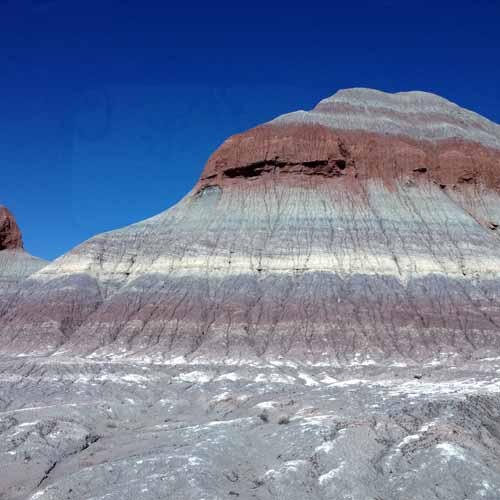
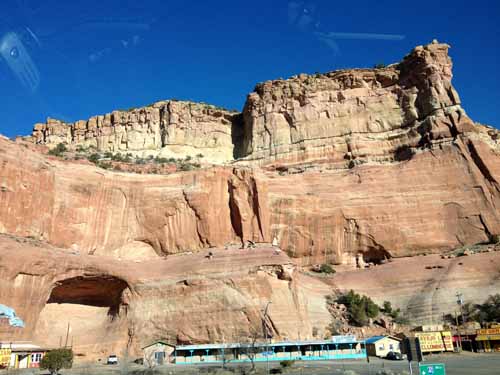
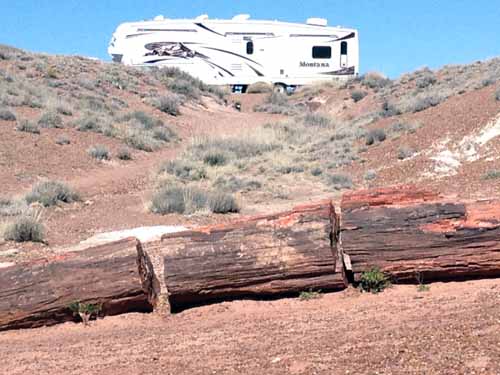
The White Goddess has a great sound system in it, and we are able to put our entire 15,000+ song music library on a thumb drive and listen as the miles pass. On this drive we realized our truck's sound system had become psychic. When we approached a great cliff our friend Joe Crookston began singing "Building Walls"; then as we passed a pile of rocks at the exit for Joseph City he began to sing "Stone By Stone".
We crossed the continental divide on our way, and the stuff I learned in school is true - the eastern side is desert and the western side has much more water, thus trees and green stuff. Appropriately enough for folkaholics such as ourselves there was an enormous train as we made the crossing, bringing to mind the Carter Family's "Railroading On The Great Divide". As with most psychic phenomena, they were erratic and the psychic sound system failed to play the song at the right time. Kate Wolf's version of Railroading was running through my head, though.
A funny thing happens when you go up higher in the mountains, it gets colder and snows. We arrived at the Grand Canyon on March 5 to find several inches of snow on the ground. It's easy to hook up the water and electric supplies to a trailer in the snow, but have you ever tried to find a four inch pipe cover for the sewer under a blanket of the white stuff? By the time we found it the pristine blanket of snow looked like a herd of wild elk (they don't have elephants at the grand canyon) had trampled through. Surprisingly, the campground was practically full, even in this off season, from the look of most of our neighbors they were either retirees like us of Japanese tourists in rented RVs seeing our country.
The first evening we went over to the Market Plaza to see what was there. They have a Chase Bank, a Post Office, a pretty good (but not surprisingly expensive) grocery store, snack bar and even a nice restaurant, but it was closed for refurbishing so we couldn't try it. We drove, but found that the Market was walking distance from the RV park.
Getting around the South Rim of the park (the North Rim was still closed for winter) is simplicity itself, just walk to the bus stop and hop on. The bus is included in your park admission. The drivers will often tell you about the places you're going and you don't have to worry about dodging animals in the road or making a wrong turn. Not only that, but with the buses you don't have to fight with a million other tourists for parking. Nice to find the government is doing something right!
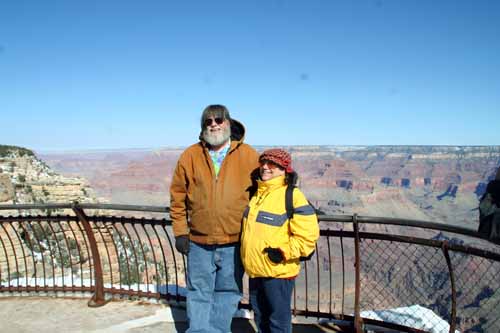
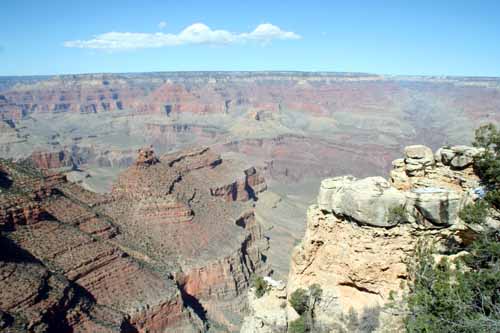
There is simply no way to describe the grandeur of this place. Words are weak; we were reduced to things like "Oh Wow", "Fantastic!" and inarticulate grunts and suckings of breath. Pictures are too small; a hole in the ground one mile deep just won't fit in a 4×6 frame. On a clear day the colors are amazing, the textures are so vivid you want to reach out and slide you hand over them like petting a dog. You can look out and see hair thin lines along the surface with the occasional ant wandering along them; those are the hikers heading along the trails to the bottom of the canyon. If you don't want to walk you can ride a mule, but we opted to just look without excess exercise. In place of riding a mule we made the acquaintance of some elk, who were completely oblivious to the people around them, casually munching an the greenery.
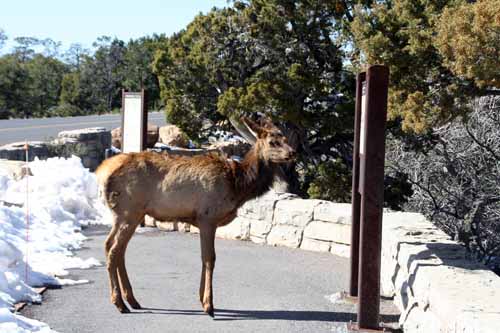
Here and there you can see the Colorado River wandering along. It looks muddy brown, but is actually a normal blue when you get close. The brown is a reflection of the red-brown cliffs that it has cut through over millions of years. If you look closely you can see the footbridge across the river in the picture below. Looking down you can also see green places where the trees were starting to leaf out. Since the bottom of the canyon is about one mile lower than the rim, spring comes several weeks earlier down there.
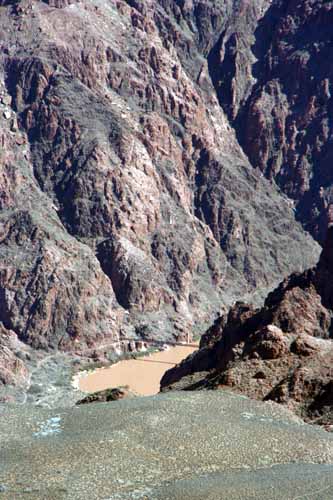
As with so many of our national and state parks, the Civilian Conservation Corps has left a legacy of wonderful buildings and stonework for us to enjoy. The CCC was a remarkable effort, giving employment to thousands of young men at the height of the depression. They worked for $30 a month and had to send $25 of that home to their families. Since they were usually based in the middle of nowhere there wasn't that much to spend their $5 on, I suppose. In any case, by the time their hitch was up they had been trained in valuable skills and were far better off when it came to finding a job. Too bad our current congress isn't able to learn from history.
When the conditions are right, sunset at the canyon is spectacular. I froze my fingers off to get this shot, but it was worth it. I also caught a shot of a group of teenagers fooling around at the rim of the canyon as we waited for the sunset.
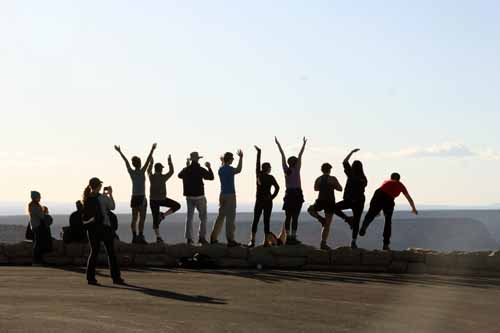
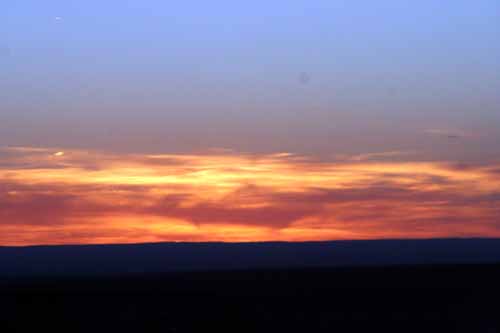
One of the more interesting parts of the visit was the Desert View Watchtower. Designed by architect Mary Colter and built in 1932, the 70′ tower has a hidden steel frame but only the native stone is visible. The interior decoration is stunning and the view of the canyon is superb.
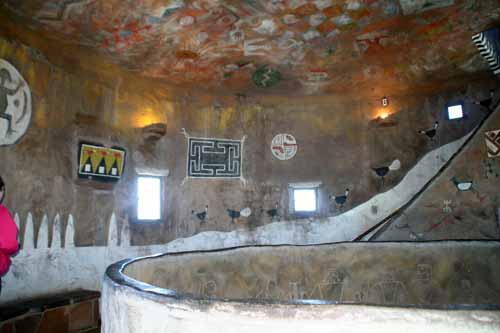
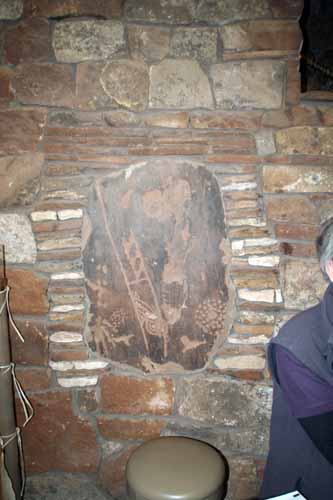
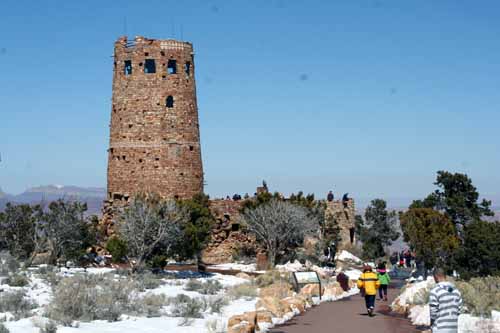
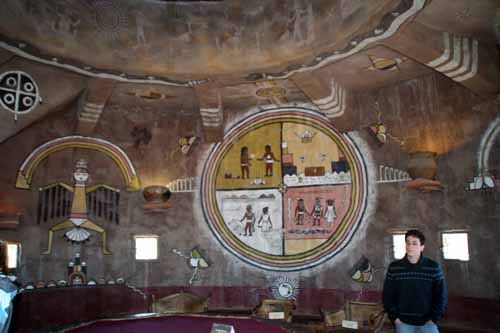
After a couple of days even the Grand canyon starts to be a bit familiar, so we took a side trip to the Cameron Trading Post on the advice of some of our fellow vacationers, stopping along the way at several of the numerous roadside vendors. These local craftsmen, mostly Native Americans, had some beautiful jewelry and such at very reasonable prices, and most were quite willing to tell you about the area and themselves. We met quite a few really nice people along the way.

Our informants were right - the Cameron Trading Post is something to see. It certainly wasn't your kitschy "Trading Post" filled with plastic junk from Taiwan, but had a great variety of arts and crafts from the Southwest, many of which were far above our budget but worth the asking price. A fun place to visit.
Our last day in the canyon was a rest day, we couldn't get up the energy to do anything more than sit and read. Amazing how tired you can get while having fun.
After our rest we headed South toward Scottsdale AZ and Frank Lloyd Wright's Taliesin West. Our gas mileage for the trip was terrific, since we dropped over a mile in elevation on the trip, also traveling from spring to high summer. We found an RV park about half an hour away, but there wasn't a space available for two consecutive days so we had to move the trailer the next morning before we headed for Taliesin.
Before touring Taliesin we toured the Best Buy - my trusty 13 year old camera was dying. If you look closely at some of the previous pictures of the sky you might notice some blobs floating in the blue. The sensor in the camera was failing, the battery compartment wouldn't close and the lens was starting to make funny sounds as it focused. Since my Canon Rebel XT had served me well I got the current low-end version of the Rebel, the Rebel T5. (I didn't need all the bells and whistles, just the ability to take nice pictures.) So the pictures from now on have pristine blue skies, something there is a lot of in the desert.
The more we learn about Wright (although he really seems like someone who we would like to know well enough to call him Frank) the more interesting he becomes. The buildings he created are brilliant, but his cranky, quirky personality are as interesting as his architectural skills. As he grew older the Wisconsin winters were getting to be a bit too much (something we can agree with!), so he built a winter home in Arizona. He, his family and his students migrated between Taliesin East and West each year as the seasons changed.
Our guide was full of interesting tidbits about both the Wrights and the physical structure. Taliesin West being in the desert, water was a problem. After a lucrative commission, Wright paid $10,000 to have a well drilled to remedy the problem. Since he paid somewhere around $2,000 for the property you can see this was another of Wright's flamboyant gestures. The driller was ready to give up after several hundred feet of dry well, but Wright let him know in no uncertain terms that he paid for a water well and he was damned sure he would have water before the driller weft his property. As you can see from the pictures, he got his water and plenty of it. There's even an orange tree in the garden.
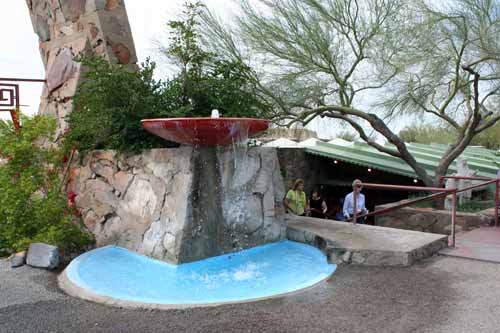
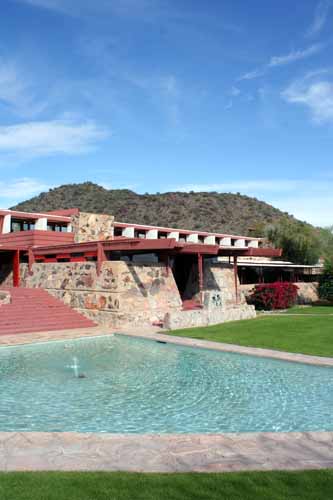
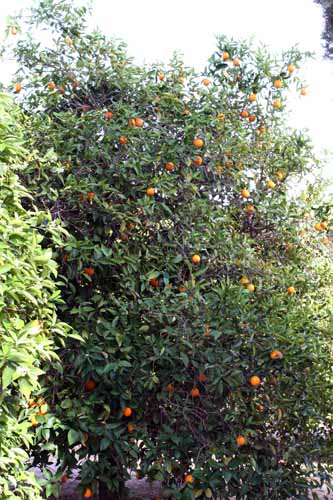
The pools and landscaping serve two purposes - they were a reserve of water if a fire broke out (always a concern in that era) but the pools and grass were created so that Wright's apprentices had a place for their children to swim and play. As egocentric and demanding as Wright was, he always had a soft spot for children and took them into consideration in his designs.
Once again Wright's ideas outstripped the available materials to turn them into reality. The roof of his office was made of translucent canvas, providing natural light, but was not very durable (it has since been replaced by translucent plastic). Each summer his apprentices had the task of removing the panels and storing them before migrating to Wisconsin, then taking the panels from storage in the fall and hoisting them up to the roof once more. Wright's wife had the task of sweeping the winter's debris from the office as the roof was re-installed.
The sleeping arrangements at Taliesin were interesting. His apprentices lived in tents in the desert, a practice that continues today with many of the students at the Wright School of Architecture. Wright himself had two beds in his bedroom. One was by a large window, visible from the outside; the other was behind a partition. If he was sleeping in the window bed you could disturb the Great Architect; if he was behind the partition you came back at another time.
A few assorted facts that stuck in my mind:
- The garden comes complete with a fire breathing dragon, and Wright greatly enjoyed surprising his guests with it's fiery breath. Joseph Stalin's daughter was part of Wright's household, being a friend of this third wife, Olgivanna.
- The Moon Door in the garden looks for all the world like there should be a Hobbit standing by it, but the door predates Tolkein's writing.
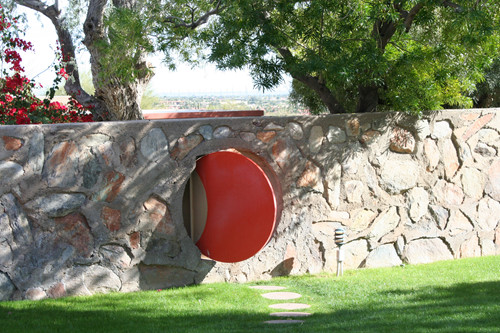
- The living room was originally open to the outside but windows were added later. Wright had several pots on the shelves that were large enough that they extended past the window line. He was unwilling to move the pots, so they cut circles in the glass to accommodate them.
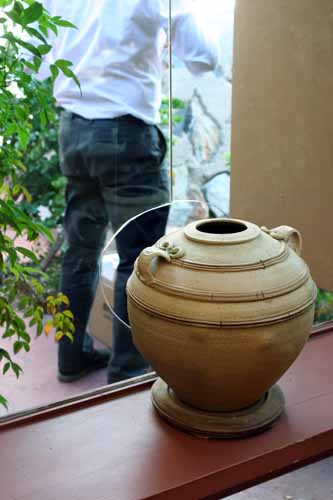
- There is a large theater as part of the complex, concerts and performances sere an essential part of life at Taliesin.
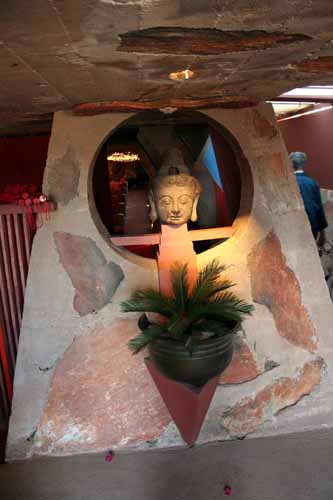
- The place is decorated with a great deal of Asian art, but much of it is damaged. Wright got a good deal on a lot damaged statuary, so he used it in his western home. After his death Olgivanna sold much of his oriental art collection to pay the bills Wright had run up and not bothered to pay.
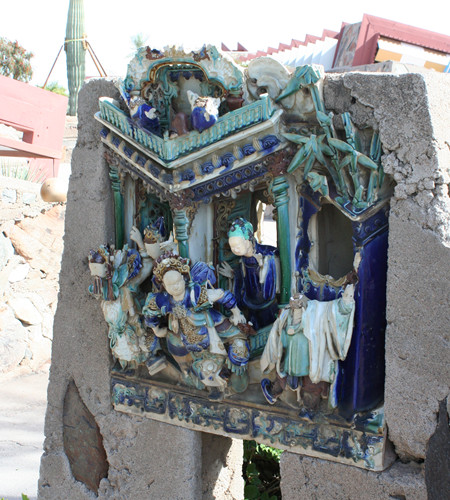
Unfortunately we got there a few days too late to see the Lego brick model of Taliesin. The model is about 8 feet by 4 feet and contains almost 200,000 Lego bricks in 11 colors and 120 shapes. I just hope we can find out what happened to the model so we can see it as we travel.